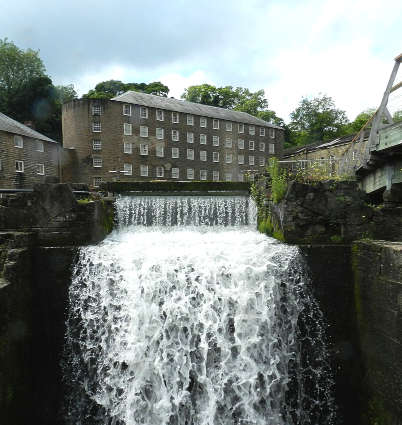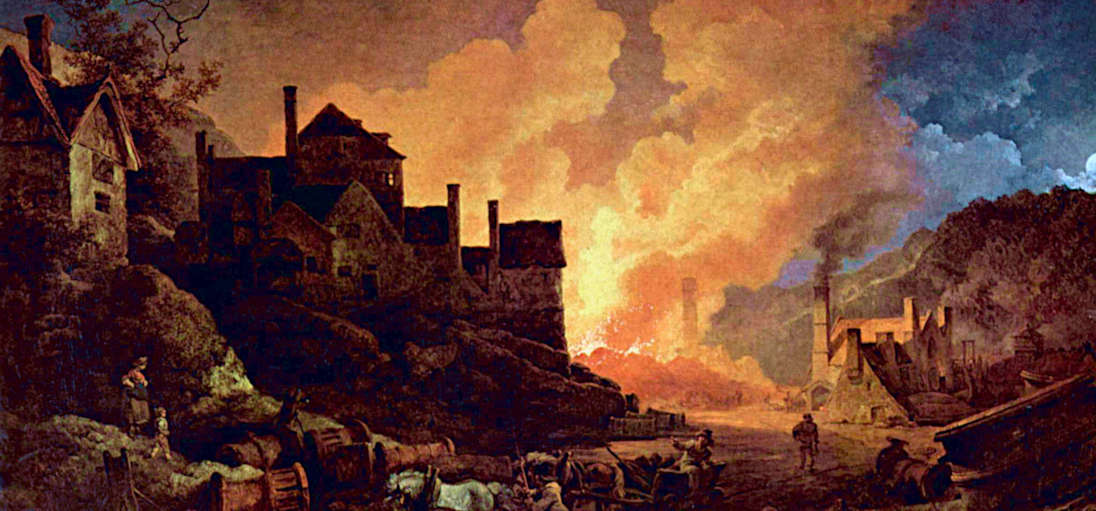Advanced level English
Economic and social history
WITH AUDIO ►: Click to open/close audio player
► For vocabulary guide, see below.
In the year 1701, a pioneering English farmer called Jethro Tull made a historic invention. By modern standards, it was a fairly simple device - a wheeled machine that allowed farmers to sow seeds in rows in their fields, rather than scattering them by hand. Yet the impact of Tull's "seed drill" was monumental. Mechanised sowing was much faster, and used far less seed, than traditional "broadcasting" by hand. It allowed farms to became bigger and more efficient, while requiring fewer workers than in the past. In short, it was one of the small details that precipitated a massive social change, allowing Britain to begin transitioning from an agricultural economy, to an industrial economy.
It was the start of the "Industrial Revolution", a historic process whereby traditional rural economies were replaced by a new economic model, based on cities and industry. The process started in Britain; but why Britain? What was special about Britain in those times?
Like other European countries, Britain had begun, in the 17th century, to set up the bases of a new commercial economy. The first banks had been founded, London had acquired a stock exchange, and other trading institutions, and international trade was developing. But what set Britain apart from other countries, notably France and Spain, was that at the same time Britain also developed other key institutions and social features that would stimulate change: a parliamentary system with political parties, more and more "public" schools to educate a part of the population, and above all a Protestant ethic, which encouraged innovation, science, work, and the generation of wealth.
Eight years after Tull invented
the seed drill, a Quaker
ironmaster called Abraham Darby developed a
new method of smelting
iron using coke instead of charcoal. This was a
pivotal breakthrough.
Coke, made from coal, was cheaper and far more
available than ch arcoal, which came from wood. People in
Europe had
been making things out of iron since prehistoric times; but until Darby
came up with his new process, making iron was a cottage industry,
concentrated in forests, where there was plenty of wood. Thanks to
Darby, it could move away from forests and rivers, and set up
production in places where there were large deposits of iron and coal.
From then on, iron could be produced on a much larger scale and at
lower costs. And significantly, new larger ironworks could make much
larger objects than in the past. Iron became a building material,
stronger and more versatile
than wood.
Offering employment for some of the men driven away from rural areas as a result of the mechanisation of agriculture, new larger industrial ironworks stimulated a rural exodus, that was to transform society in Britain over the following two hundred years. However more changes, more inventions, were needed before the new industrial age could really develop; fortunately the inventions kept coming.
 Water was the
source of power in the first industrial factories - here at Cromford
Mill, now a UNESCO world heritage site.
Water was the
source of power in the first industrial factories - here at Cromford
Mill, now a UNESCO world heritage site.One of Britain's major traditional industries was weaving, making cloth that was later transformed into clothes and fabrics. Until the middle of the 18th century, this work was done by people working at home; but then, in quick succession, three more inventions allowed the mechanisation of textile production in Britain. Within a generation, the textile industry had moved out of homes and cottages, and into large new factories, or mills as they were called at the time.
The first mills were set up next to rivers, as they needed water power to drive the new mechanical looms; but the age of water power was coming to an end. By the middle of the century, the power of steam was already being used, and in 1769 a man called James Watt discovered how to harness steam power to turn wheels. From then on, most of the ingredients needed for the development of Britain's industrial economy were in place: new factories where goods could be produced cheaply and in large quantities; people to work in the factories, and abundant sources of energy (coal) to drive the new machines with rotary motion, which were essential in most new industrial processes. All that was lacking was a transport system that could move large volumes of goods from the factories and mines, which were mostly in the north and middle of England, to the consumers in other parts of the country.
Until the eighteenth century, most goods (what we would today call consumer products) were made and sold locally. With the transport systems of the pre-industrial age, it was not easy to move goods in large quantities from the place of production, to distant places of consumption. The roads of the time, and the few new canals, were totally inadequate, and transport was very slow.... and dangerous. Nevertheless, being an island, Britain already had one big advantage over the countries of continental Europe; goods could be transported quite easily, and in larger quantities, around the coast. Indeed, since the 14th century, people in London had been burning coal mined near Newcastle, 300 miles away in the northeast of England. But few coal mines were at the seaside, most of them, and most factories, were inland. A new, faster and more direct transport network was required. It did not take long to appear.
In the year 1801, a Cornish engineer called Richard Trevithick adapted Watt's steam engine to create the world's first steam-powered vehicle. Within twenty years, the first railways were being built. The first intercity passenger railway, between the industrial cities of Liverpool and Manchester, opened in 1830; from then on, everything was in place for the development of the new industrial economy.
Being the world's first industrial economy, Britain remained the main economic power for almost a century. Yet other countries were looking on, and adapting their economies too. Though the British industrial economy kept growing throughout the 19th century, other countries were catching up, and by 1870 both Germany and the United States were vying for the position of world's leading economy. Slowly the relative importance of the British economy declined ; and after the "industrial age" drew to an end in the 1980's, the decline continued. Today Britain remains among the top six or seven economic powers in the world, but the era when it led the world is now well in the past.
.
WORDS device: machine, apparatus - seeds: grains to sow - stock exchange: place where stocks, i.e. participation in companies, are bougt and sold - ethic: philosophy, code of morals - innovation: something new - Quaker: a strict Protestant - smelting: producing in a fire - breakthrough: innovation - versatile: flexible, usable in many ways - stimulate: provoke, cause - exodus: movement out of one place and to another - cloth: textiles before anything is made from them - fabrics: finished textiles - looms: machines on which wool or other textiles can be worked - to harness: to use - lacking: absent - Cornish: from Cornwall - vying: competing.Industrial Revolution heritage sites in Britain. Major sites from the Industrial Revolution were among the first in Britain to listed as UNESCO World Heritage sites. The two key sites are the multiple site at Ironbridge Gorge, known as the Birthplace of the Industrial Revolution, and the Derwent Valley Mills, the world's first mechanised factories.
Copyright © Linguapress. Do not copy this document to any other website
Copying permitted for personal study, or by teachers for use with their students
STUDENTS' WORKSHEET - printable
The Industrial Revolution in Britain
Interactive exercises. Use on screen or on paper : in preparation.
1. Sequencing. Put these eight sentences into chronological order, based on information from the text, for example a = 8 (this is wrong!)b. The steam engine is adapted, creating the first steam-powered vehicle.
c. The first banks are set up in Britain.
d. Other countries begin catching up with Britain's industrial economy.
e. Mechanised farming reduces the need for rural labor, pushing people to find work elsewhere.
f. A new method of smelting iron using coke makes large-scale iron production possible.
g. The first passenger railway line connects two major industrial cities.
h. Steam power begins to replace water power in driving industrial machines.
2 Vocabulary and understanding. Working from memory, if possible, select the correct option from each of the selection boxes, to reconstitute the original paragraph.
3 Correct the mistakes. Here is a copy of part of the article, Unfortunately, it contains twenty mistakes. Mistakes may concern vocabulary or grammar. Can you pick them out, and correct them, changing the text as little as possible. The extract in the box below can be directly edited, and the new text you type will show in red. To print or save your changes, either print the page, or save it as a .pdf file.
For teachers
Warm up activity.
Ask students if they know what is implied by the expression "Industrial revolution". Maybe they will have no idea. If so, tell thm that it was a period in history when countries moved from an essentially rural economy, to an industrial economy. Now ask them for more ideas.
This article is very concentrated; it covers two centuries of British socioeconomic history, in just over 1000 words, and for this reason it fails to mention many of the collateral effects of the Industrial Revolution, and many of the negative sides of economic change in Britain and Europe in the 18th century. It was an age when a lot of families grew rich on the proceeds of slavery, and the men and women who went to work in the new cities and factories - not to mention the coal mines - were often exploited, working long hours in bad conditions for little pay. On the other hand, badly paid work in the factories was often the lesser of two evils – the other being no work at all, and abject poverty in struggling rural communities. Conditions were harsh. It can be noted that while slavery was essential for the economies of many British colonies, specially in the Caribbean, slavery was never legal in Britain itself.
The Industrial Revolution was a massive upheaval, during which British society was transformed; in the end, the wealth it generated began to slowly trickle down to the masses, and during the nineteenth century a new social awareness began to grow, leading to better living conditions for most of the population, education for all children, and the social reforms that followed.
The Quakers: these non-conformist Protestants played a major role in the Industrial Revolution in Britain and in other countries too. Several important British companies were founded by Quakers, and some of their names are still known today: Cadbury, Rowntree, Barclay (of Barclay's Bank). As for "Quaker oats", a brand that is known worldwide to this day, it was not founded by Quakers, but the name and logo were chosen to convey the message that the company was well run and trustworthy.
Grammar: subordinate clauses
This text contains over twenty subordinate clauses; pay attention in particular to the eleven relative clauses, that allowed farmers… / which encouraged innovation… / that could move… etc. All the relative clauses refer to facts or objects, so they all start with that or which, never with who.
► Note also two "nominal relative clauses", also known as a "free relative clauses", In paragraph 3 ", But what set Britain apart from other countries", and in para. 8 (what we would today call consumer products).
Answer key for exercise 1. a = 4, b = 6. c = 1, d = 8, e = 2, f = 3, g = 7, h = 5 .





 Copyright
information.
Copyright
information.